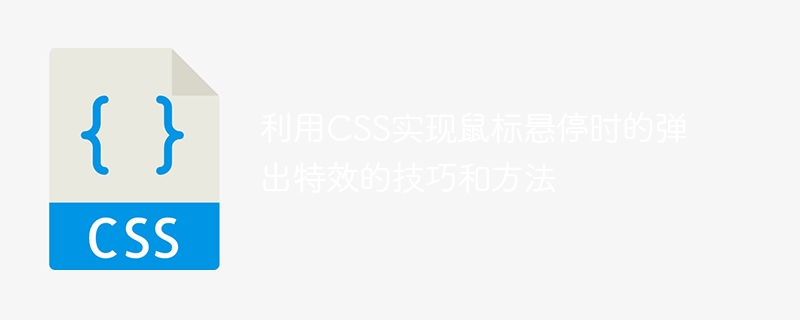

Techniques and methods of using CSS to achieve pop-up special effects when the mouse is hovering
In the design of web pages, we often encounter situations where pop-up special effects are required when the mouse is hovering. Requirements, this special effect can improve user experience and page interactivity. This article will introduce the techniques and methods of using CSS to achieve pop-up effects when the mouse is hovering, and provide specific code examples.
1. Use the transition property of CSS3 to implement gradient animation
The transition property of CSS3 can implement gradient animation of elements. By setting the appropriate transition time and transition effect, the element can be made to hover when the mouse is hovering. Produces a smooth pop-up effect.
Code example:
In the above code, by setting the transition attribute of the .box element to transform 0.3s ease, that is, the change of the transform attribute is transitioned with an easing effect within 0.3 seconds. When the .box element is hovered by the mouse, a new transform style is applied through the :hover pseudo-class selector to scale the element to 1.1 times its original size.
2. Use the animation property of CSS3 to achieve elastic animation
The animation property of CSS3 can achieve the elastic animation effect of the element. By setting key frames and transition time, the element can be made to move when the mouse is hovering. A pop-up effect that exhibits a spring effect.
Code example:
In the above code, two keyframe animations are defined: pop and pop-hover. By setting the animation attribute of the .box element to pop 0.3s ease, when the element is hovered by the mouse, set the new animation attribute to pop-hover 0.3s ease through the :hover pseudo-class selector to achieve elastic animation of the element.
3. Use the transform attribute of CSS to realize displacement animation
In addition to the scaling effect and elasticity effect, we can also realize the displacement animation of the element through the transform attribute of CSS, so that it can be moved when the mouse is hovering. Pops up in a certain way when stopped.
Code example:
In the above code, by setting the transition attribute of the .box element to transform 0.3s ease, when the .box element is hovered by the mouse, it is selected through the :hover pseudo-class The converter sets a new transform style and moves the element up 10 pixels in the vertical direction through translateY(-10px).
To sum up, CSS can be used to achieve pop-up special effects when the mouse is hovering, including scaling animation, elastic animation and displacement animation. By rationally using CSS attributes and pseudo-class selectors, we can add more interactive effects to the page and improve the user experience and page appeal.
The above is the detailed content of Tips and methods for using CSS to achieve pop-up effects when the mouse is hovering. For more information, please follow other related articles on the PHP Chinese website!